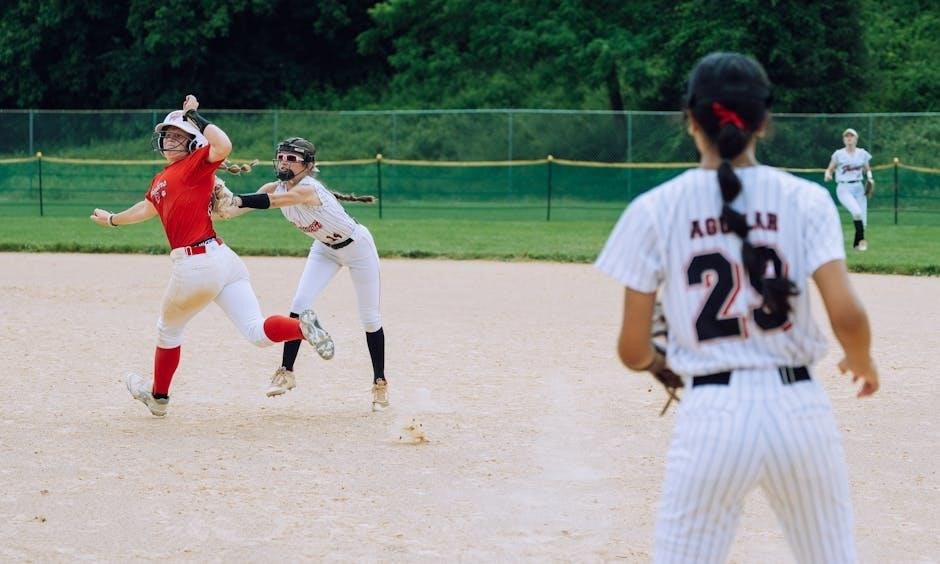Softball defensive situations require strategic planning and player positioning to outmaneuver opponents and secure wins‚ utilizing effective tactics and clever plays to gain a competitive edge in the game naturally.
Understanding the Importance of Defense in Softball
Defense is a crucial aspect of softball‚ as it can make or break a team’s chances of winning. A solid defensive strategy can help a team prevent opponents from scoring‚ while also creating opportunities for counterattacks. According to experts‚ softball is 90% mental‚ which means that a team’s defensive mindset and approach can greatly impact the outcome of a game. By understanding the importance of defense‚ coaches and players can develop effective strategies to outmaneuver opponents and gain a competitive edge. This includes identifying key positions‚ such as the pitcher and first baseman‚ and developing tactics to convert ground balls into outs. By prioritizing defense‚ teams can improve their overall performance and increase their chances of winning. Effective defense also requires a deep understanding of the game‚ including the ability to read plays and make quick decisions. With the right approach‚ defense can become a team’s strongest asset.

Basic Softball Defensive Strategy
Effective softball defense involves fundamental components like pitching strikes and converting ground balls into outs‚ using clever tactics naturally every time.
Key Positions and Responsibilities
The pitcher and first baseman are crucial positions in softball defense‚ with the pitcher throwing strikes and the first baseman catching ground balls to convert them into outs.
The right fielder also plays a vital role‚ backing up first base on thrown balls and tracking fly balls hit to the outfield.
Each position has specific responsibilities‚ including the catcher covering first base‚ the second baseman covering second base‚ and the shortstop pursuing the ball.
Understanding these responsibilities is essential for effective teamwork and defense.
The defensive strategy should be tailored to the team’s strengths and weaknesses‚ with players positioned to maximize their abilities.
By assigning clear responsibilities to each position‚ the team can work together seamlessly to outmaneuver their opponents.
Effective communication and coordination among players are also critical to successful defense‚ allowing them to respond quickly to different game situations.
Overall‚ a well-coordinated defense can make a significant difference in the outcome of a game‚ and understanding key positions and responsibilities is essential for achieving this goal.
Defensive Playbook for 10U Softball Team
A 10U softball team’s defensive playbook includes strategies for pitching strikes and converting ground balls into outs to win games naturally and effectively;
Emphasizing Pitching Strikes and Ground Balls
Emphasizing pitching strikes and ground balls is crucial for a softball team’s defensive success‚ as it allows for more control over the game’s outcome; A pitcher who can consistently throw strikes and induce ground balls can greatly reduce the opposing team’s scoring opportunities. This approach also puts pressure on the opposing team’s hitters‚ forcing them to make contact with the ball in a way that is more likely to result in an out. By focusing on pitching strikes and ground balls‚ a team can create a strong defensive foundation and improve its overall chances of winning. Effective pitching and defense can be a winning combination‚ and teams that master these skills are often the most successful. Pitching strikes and ground balls requires a combination of skill‚ strategy‚ and practice‚ but the benefits to a team’s defensive performance can be significant.

Defensive Situations and Strategies
Defensive situations and strategies involve clever tactics and player positioning to outmaneuver opponents naturally every time in the game with great skill and expertise always.
Single to Left: Bases Empty
In a situation where a single is hit to left field with bases empty‚ the catcher’s primary responsibility is to cover first base in case the runner takes a wide turn‚ while the pitcher backs up any throw to second base. The first baseman checks that the batter touches first base and then backs up the incoming throw to second base. The second baseman covers second base‚ and the shortstop pursues the ball before throwing to the appropriate base. This strategic positioning is crucial in preventing the runner from advancing to second base and potentially scoring. By understanding the roles and responsibilities of each defensive player‚ teams can effectively execute defensive strategies and minimize scoring opportunities for their opponents. Effective communication and teamwork are essential in these situations‚ and players must be able to react quickly and make smart decisions to outmaneuver the opposing team.
Single to Center: Bases Empty
When a single is hit to center field with bases empty‚ the defensive team must be prepared to react quickly to prevent the runner from advancing to second base. The center fielder is responsible for tracking the ball and making a swift throw to the appropriate base‚ while the other outfielders provide backup support. The infielders‚ including the second baseman and shortstop‚ move into position to receive the throw and make a play on the runner. The key to success in this situation is for the defensive players to communicate effectively and work together seamlessly. By doing so‚ they can minimize the runner’s opportunity to advance and potentially score. The pitcher and catcher also play important roles‚ as they must be prepared to back up any throws and make strategic decisions to outmaneuver the opposing team. Effective teamwork and strategic thinking are essential in these situations‚ and teams that can execute their defensive strategy effectively will be well-positioned to succeed.
Single to Right: Bases Empty
In the event of a single being hit to right field with no runners on base‚ the defensive team’s primary objective is to prevent the runner from reaching second base. The right fielder is tasked with quickly retrieving the ball and making an accurate throw to the appropriate base‚ while the other outfielders provide support and backup. The infielders‚ including the first baseman and second baseman‚ move into position to receive the throw and make a play on the runner. It is crucial for the defensive players to communicate effectively and work together to minimize the runner’s opportunity to advance. The right fielder’s ability to make a strong and accurate throw is particularly important in this situation‚ as it can significantly impact the team’s ability to prevent the runner from reaching second base. By executing their defensive strategy effectively‚ teams can gain a competitive edge and limit the opposing team’s scoring opportunities‚ ultimately contributing to their overall success. Effective defensive play can make a significant difference in the outcome of the game.
Advanced Defensive Strategies
Teams employ advanced defensive strategies to outmaneuver opponents‚ utilizing clever tactics and plays to gain a competitive edge naturally every time.
Runner on First‚ or Runners on First and Third
In softball defensive situations‚ having a runner on first or runners on first and third base can be challenging for the defense. The key is to anticipate the next play and position players accordingly. The pitcher should be aware of the runner on first and try to prevent a steal. The first baseman should be prepared to catch a pick-off throw from the pitcher‚ while the second baseman should cover the steal. If there are runners on first and third‚ the defense should be prepared for a squeeze play or a steal of home. The catcher should be aware of the runner on third and try to prevent a steal of home. The defense should also be prepared for a bunt or a hit to the outfield‚ and the outfielders should be positioned to cut off the ball and prevent the runner from advancing. By anticipating the next play and positioning players correctly‚ the defense can minimize the opponent’s scoring opportunities. Effective communication and teamwork are crucial in these situations to outmaneuver the opponent and secure a win.
Importance of Right Fielder in Defensive Situations
The right fielder plays a crucial role in softball defensive situations‚ particularly when it comes to backing up throws to first base. According to defensive strategies‚ the right fielder should be the team’s best outfielder‚ as they are responsible for covering a significant amount of ground and making accurate throws to the infield. The right fielder’s ability to track fly balls and line drives is also essential‚ as they must be able to make quick decisions and react accordingly. In addition‚ the right fielder must be able to read the ball and anticipate where it will be hit‚ allowing them to position themselves for the best possible chance of making a play. By having a skilled right fielder‚ teams can minimize the opponent’s scoring opportunities and gain a competitive edge. Effective right fielders can also help to prevent extra-base hits and turn doubles into singles‚ ultimately contributing to the team’s overall defensive success. The right fielder’s importance cannot be overstated‚ and teams should prioritize placing their best outfielder in this position.